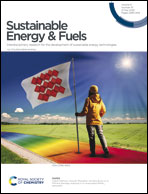Techno-economic, life cycle, and environmental cost assessment of biojet fuel obtained from Pinus pinaster by turpentine hydrogenation†
Abstract
The reduction of greenhouse gas (GHG) emissions caused by the aviation industry is a complex challenge. Biojet fuels can significantly contribute to lowering the GHG emissions, but their cost is still a major issue. In this study, life cycle assessment (LCA) and environmental cost assessment were used to evaluate the production of biojet fuel obtained from Pinus pinaster resin in Spain through hydrogenation of turpentine. Both studies were carried out using the software SimaPro. The Product Environmental Footprint (PEF) method was employed to quantify the environmental impacts. A process simulation scheme with Aspen Plus was carried out to evaluate the feasibility of an industrial implementation and to assess mass and energy balances for being used in the LCA. Production and external costs due to environmental impacts obtained by the Environmental Prices methodology have been considered. The results show that emissions are 5.9 g CO2 eq. per MJ, when a yield of 4 kg of resin per tree per year is considered, which means a reduction of 93% compared to the fossil jet fuel (stated in Directive (EU) 2018/2001 as being of 94 g CO2 eq. per MJ). In addition, if the resin yield increases above 6 kg per tree per year or/and if environmental externalities are considered, biofuel becomes cost-competitive compared to fossil jet fuel. In conclusion, this research shows that the biofuel obtained from pine resin hydrogenation is cost-competitive and can be blended with traditional jet fuel to reduce the environmental impact of the GHG emissions from the aviation industry.



 Please wait while we load your content...
Please wait while we load your content...